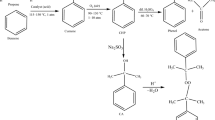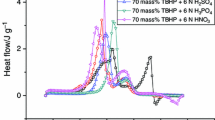Abstract
Numerous fires and explosions have occurred in chemical industries in Taiwan. In addition to considerable damage to equipment, such accidents cause environmental damage and even social turmoil, and they remind us of the importance of industrial process safety. Many of these accidents involve organic peroxides, which become extremely labile or unstable if they contact acids, bases, or other incompatibles. This study established thermokinetic and thermal safety parameters by differential scanning calorimetry and a thermal activity monitor III for cumene hydroperoxide (CHP) and its incompatibles. For the first time, this study reports the first real-time observation of the reaction of CHP with sulfuric acid by thermal imaging camera, which was used to determine the rate of heat evolution and recognize the degree of hazard present during thermal incidents.








Similar content being viewed by others
Abbreviations
- C :
-
Number of atoms of carbon (dimensionless)
- E a :
-
Apparent activation energy (kJ mol−1)
- H :
-
Number of atoms of hydrogen (dimensionless)
- O :
-
Number of atoms of oxygen (dimensionless)
- Q max :
-
Maximum peak power at time t (W g−1)
- R :
-
Gas constant (8.314 J mol−1 K−1)
- T :
-
Absolute temperature (K)
- T 0 :
-
Exothermic onset temperature (°C)
- T max :
-
Maximum temperature (°C)
- T P :
-
Peak of temperature (°C)
- TMRiso :
-
Time to maximum rate under isothermal conditions (h)
- β :
-
Scanning rate (°C min−1)
- ΔH d :
-
Heat of decomposition (J g−1)
References
Liu SH, Hou HY, Chen JW, Weng SY, Lin YC, Shu CM. Effects of thermal runaway hazard for three organic peroxides conducted by acids and alkalines with DSC, VSP2, and TAM III. Thermochim Acta. 2013;566:226–32.
Wu SH, Shyu ML, Yet-Pole I, Chi JH, Shu CM. Evaluation of runaway reaction for dicumyl peroxide in a batch reactor by DSC and VSP2. J Loss Prev Process Ind. 2009;22:721–7.
Chen KY, Wu SH, Wang YW, Shu CM. Runaway reaction and thermal hazards simulation of cumene hydroperoxide by DSC. J Loss Prev Process Ind. 2008;21:101–9.
Duh YS, Kao CS, Wang HH, Lee WL. Thermal decomposition kinetics of cumene hydroperoxide. Process Saf Environ Prot. 1998;76:271–6.
OHS ROM. MHIDAS (Major Hazard Incident Data Service): Reference Manual. USA; 2006.
Graham SR, Hodgson R, Vechot L, Essa MI. Calorimetric studies on the thermal stability of methyl ethyl ketone peroxide (MEKP) formulations. Process Saf Environ Prot. 2011;89:424–33.
Somma ID, Marotta R, Andreozzi R, Caprio V. Kinetic and chemical characterization of thermal decomposition of dicumylperoxide in cumene. J Hazard Mater. 2011;187:157–63.
Li AC, Tsai YT, Wu SH, Chiu CW, Shen SJ, Chang RH, Shu CM. Thermal runaway analyses for two organic peroxides with H2O and dry fire-extinguishing chemicals by DSC and VSP2. J Therm Anal Calorim. 2013;113:1611–8.
Chu YC, Chen WT, Tsai FC, Tsai LC, Lin FR, Shu CM. Evaluation unexpected energy released for three liquid organic peroxides. Energy Educ Sci Technol Part A. 2012;30:977–82.
Duh YS, Kao CS, Lee C, Yu SW. Runaway hazard assessment of cumene hydroperoxide from the cumene oxidation process. Process Saf Environ. 1997;85:73–80.
You ML, Tseng JM, Liu MY, Shu CM. Runaway reaction of lauroyl peroxide with nitric acid by DSC. J Therm Anal Calorim. 2010;102:535–9.
Luo KM, Chang JG, Lin SH, Chang CT, Yeh TF, Hu KH, Kao CS. The criterion of critical runaway and stable temperatures in cumene hydroperoxide reaction. J Loss Prev Process Ind. 2001;14:229–39.
Chi JH, Wu SH, Shu CM. Thermal explosion analysis of methyl ethyl ketone peroxide by non-isothermal and isothermal calorimetric applications. J Hazard Mater. 2009;171:1145–9.
Huang CC, Peng JJ, Wu SH, Hou HY, You ML, Shu CM. Effects of cumene hydroperoxide on phenol and acetone manufacturing by DSC and VSP2. J Therm Anal Calorim. 2010;102:579–85.
Hou HY, Shu CM, Tsai TL. Reactions of cumene hydroperoxide mixed with sodium hydroxide. J Hazard Mater. 2008;152:1214–9.
Seubold FH, Vaughan WE. Acid-catalyzed decomposition of cumene hydroperoxide. J Am Chem Soc. 1953;75:3790–2.
Wu SH. Runaway reaction and thermal explosion evaluation of cumene hydroperoxide(CHP) in the oxidation process. Thermochim Acta. 2013;559:92–7.
Hou HY, Duh YS, Lee WL, Shu CM. Hazard evaluation for redox system of cumene hydroperoxide mixed with ingranic alkaline solutions. J Therm Anal Calorim. 2009;95:541–5.
Chou HC, Wu SH, Chiang CC, Horng JJ, Chi JH, Shu CM. Effects of stirring rate for thermal runaway reaction in cumene hydroperoxide manufacturing process using calorimetric techniques. J Therm Anal Calorim. 2011;106:243–8.
Shen SY, Chen JC, Liu SH, Liaw HJ, Shu CM. Effects of upper explosion limit for isopropyl alcohol by steam inerting at 1 atm and 150 °C by 20-L-apparatus. J Therm Anal Calorim. 2013;113:1619–24.
Chen WT, Ma CC, Lee MH, Chu YC, Tasi LC, Shu CM. Silver recovery and chemical oxygen demand (COD) removal from waste fixer solutions. Appl Energy. 2012;100:187–92.
Tasi FC, Ma N, Tasi LC, Tao J, Chiang TC, Chu YC, Chen WT, Shu CM. Sulfonated polystyrene/PTFE as proton exchange membrane for PEM fuel cell application. Energy Educ Sci Technol Part A. 2012;30:1137–42.
Jhu CY, Wang YW, Wen CY, Shu CM. Thermal runaway potential of LiCoO2 and Li(Ni1/3Co1/3Mn1/3)O2 batteries determined with adiabatic calorimetry methodology. Appl Energ. 2012;100:127–31.
Weng SY, Liu SH, Tsai LC, Hsieh TF, Ma CM, Shu CM. Thermokinetics simulation for multi-walled carbon nanotubes with sodium alginate by advanced kinetics and technology solutions. J Therm Anal Calorim. 2013;113:1603–10.
Center for Chemical Process Safety (CCPS). Guidelines for safe storage and handling of reactive materials. New York: American Institute of Chemical Engineers (AIChE); 1995.
Lothrop WC, Handrick GR. The relationship between performance and constitution of pure organic explosive compounds. Chem Rev. 1948;44:419–45.
Frurip D. Using the ASTM CHETAH program in chemical process hazard evaluation. Process Sas Prog. 1992;11:224–8.
Shanley ES, Melhem GA. A review of ASTM CHETAH 7.0 hazard evaluation criteria. J Loss Prev Process Ind. 1995;8:261–4.
Mettler Toledo. STARe Software with Solaris Operating System: Operating Instructions. Mettler Toledo; 2016.
Hou HY, Su CH, Shu CM. Thermal risk analysis of cumene hydroperoxide in the presence of alkaline catalysts. J Loss Prev Process Ind. 2012;25:176–80.
Zanga NA, Qiana XM, Liao JY, Shu CM. Thermal stability of lauroyl peroxide by isoconversional kinetics evaluation and finite element analysis. J Taiwan Inst Chem Eng. 2013;. doi:10.1016/j.jtice.2013.06.004.
Tsai YT, You ML, Qian XM, Shu CM. Calorimetric techniques combined with various thermokinetic models to evaluate incompatible hazard of tert-butyl peroxy-2-ethyl hexanoate mixed with metal ions. Ind Eng Chem Res. 2013;52:8206–15.
Lee MH, Chen JR, Shiue GY, Lin YF, Shu CM. Simulation approach to benzoyl peroxide decomposition kinetics by thermal calorimetric technique. J Taiwan Inst Chem Eng. 2014;45:115–20.
Wang YW, Liao MS, Shu CM. Thermal runaway hazards for LiCoO2 Li-ion batteries by DSC tests. Energy Educ Sci Technol Part A. 2012;30:1–4.
Wang TS, Liu SH, Qian XM, You ML, Chou WL, Shu CM. Isothermal hazards evaluation of benzoyl peroxide mixed with benzoic acid via TAM III test. J Therm Anal Calorim. 2013;113:1625–31.
Liu SH, Lin CP, Shu CM. Thermokinetic parameters and thermal hazard evaluation for three organic peroxides by DSC and TAM III. J Therm Anal Calorim. 2011;106:165–72.
Tseng JM, Liu MY, Chen SL, Hwang WT, Gupta JP, Shu CM. Runaway effects of nitric acid on methyl ethyl ketone peroxide by TAM III test. J Therm Anal Calorim. 2009;96:789–93.
TAM III Thermostat. Product information. TA Instruments. 2016. http://www.tainstruments.com/.
Wang T, Hu X, Tang D, Guo C. Infrared thermal image of vapor–liquid interface in capillary microgroove heat sink. Int J Therm Sci. 2011;50:274–9.
Erturk H. Evaluation of image reconstruction algorithms for non-destructive characterization of thermal interfaces. Int J Therm Sci. 2011;50:906–17.
Yu H, Nonn A, Heider D, Advani S. Model-based characterization and enhancement of the through-thickness thermal conductivity of polymer composites using infrared camera. Int J Therm Sci. 2014;80:118–25.
Acknowledgements
The authors appreciate the financial support from the Ministry of Science Technology of the ROC under Grant NSC 101-2221-E-407-0001-MY3.
Author information
Authors and Affiliations
Corresponding author
Rights and permissions
About this article
Cite this article
Chiang, CL., Liu, SH., Lin, YC. et al. Thermal release hazard for the decomposition of cumene hydroperoxide in the presence of incompatibles using differential scanning calorimetry, thermal activity monitor III, and thermal imaging camera. J Therm Anal Calorim 127, 1061–1069 (2017). https://doi.org/10.1007/s10973-016-5799-6
Received:
Accepted:
Published:
Issue Date:
DOI: https://doi.org/10.1007/s10973-016-5799-6




